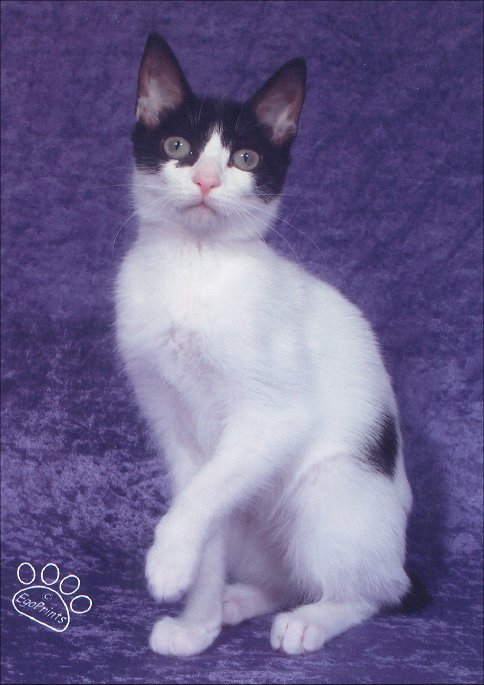 THE
ORIGIN OF THE BREED
THE
ORIGIN OF THE BREED
The earliest written evidence of cats in Japan
indicates that they arrived from China or Korea
at least one thousand years ago. For hundreds of
years bobtailed cats were highly valued and
guarded. In 1602 Japanese authorities decreed
that all cats should be set free to cope with
vermin threatening the silkworms. Buying or
selling cats was forbidden, and from that time
forward bobtailed cats lived on farms and in the
streets. Thus Japanese Bobtails are the "street
cats" of Japan.
They were first brought to the
United States by American servicemen, who had
acquired them as pets overseas. The Bobtails
attracted the attention of American cat
breeders, who imported the first breeding stock
to the United States from Japan in the 1960s.
Japanese Bobtails were granted Provisional Breed
status in 1971, and achieved Full Championship
status in CFA in 1976. The Japanese Bobtail is a
natural breed and does indeed come from Japan;
all CFA registered cats can be traced back to
the original imports.
THE MANEKI NEKO
The
Japanese Bobtail has existed in Japan for many
centuries. It is featured in many ancient
stories, art prints and paintings, and to this
day is considered good luck to have in the
house. When visiting Japanese shops, you will
often see a ceramic "maneki neko" (beckoning
cat) near the front door with one paw raised.
This traditional symbol of welcome and good luck
is a stylized rendition of the much-cherished
Japanese Bobtail cat.
The maneki
neko figurine is most frequently seen in
Japanese shop windows or by doorways offering
hospitality and good fortune to all who enter,
and good business to the owner. Large or small,
made in a variety of materials from papier mache
to fine porcelain, most are adorned with neck
ribbons with attached bells. Some have their
right paw raised, some their left. The maneki
neko is the traditional symbol which heralds the
Japanese Bobtail, its fine ancestry, and good
fortune.
The
Japanese Bobtail is a medium sized cat, well
muscled but straight and slender rather than
massive in build. The unique short tail
resembles a bunny tail with the hair fanning out
to create a pompom appearance which camouflages
the underlying bone structure. The head is
triangular in shape. The high cheekbones and
unique set of the large eyes lend a distinctive
Japanese cast to the face. Cats with two
different eye colors (odd-eyed) or with blue
eyes are quite desirable.
The Japanese Bobtail is
active, energetic and very affectionate. Their
outgoing and loving temperament make them
excellent pets. They are very intelligent and
active cats, and retain their kittenish
playfulness into adulthood. They travel well,
and adjust easily to life with dogs and other
cats. They are very adaptable and are especially
good with children.
Japanese Bobtails are strong
and healthy cats. They are active, intelligent,
talkative cats. Their soft voices are capable of
nearly a whole scale of tones; some people say
they sing. Since they adore human companionship
they almost always speak when spoken to.
They are not related to the
Manx in any way, each breed being completely
different in head and body types. The genetic
factor that creates the Japanese Bobtail is not
related to the genes which make the Manx cat
tailless.
THE DISTINCTIVE TAIL
The tail is unique not only
to the breed, but to each individual cat. Like
our finger prints, no two tails are ever alike.
The tail must be clearly visible and is composed
of one or more curves, angles, or kinks or any
combination thereof. The furthest extension of
the tail bone from the body should be no longer
than three inches. The direction in which the
tail is carried is not important. The tail may
be flexible or rigid and should be of a size and
shape that harmonizes with the rest of the cat.
The structure of the tail is camouflaged by the
tail hair, which fluffs out to resemble a
pompom.
from the body should be no longer
than three inches. The direction in which the
tail is carried is not important. The tail may
be flexible or rigid and should be of a size and
shape that harmonizes with the rest of the cat.
The structure of the tail is camouflaged by the
tail hair, which fluffs out to resemble a
pompom.
THE PORCELAIN COAT
The shorthair Japanese
Bobtail has a soft and silky coat of medium
length which appears flat rather than fluffy,
giving it the look of porcelain. Longhaired
Japanese Bobtails have belly shag and definite
britches on the hind legs. The tail leaves no
doubt as to whether the cat is a shorthair or
longhair, the tail hairs being much longer on
the longhair cats.
The Japanese
Bobtail comes in almost every color. The most
popular color is the mi-ke, pronounced "mee-kay",
a Japanese term meaning "three-furred" or what
we would call calico. It refers to a
predominantly white cat with bold patches of red
and black.
 THE
ORIGIN OF THE BREED
THE
ORIGIN OF THE BREED
